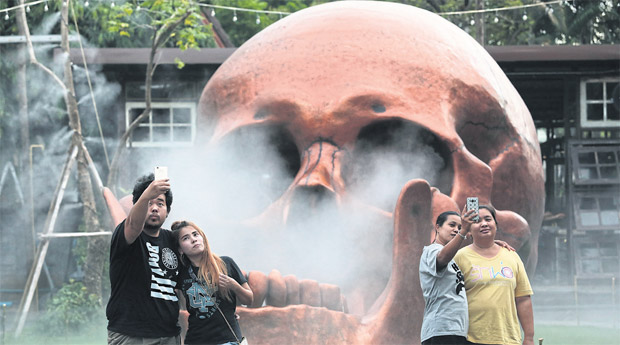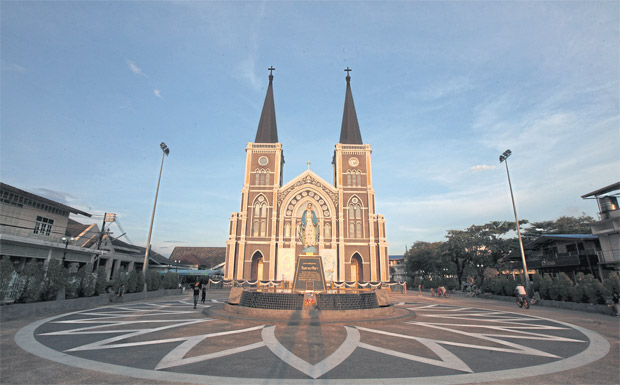After a long and tough year for many, it's nice to mark the end of it by looking ahead. Now is the time to bid farewell and embrace a fresh start by thinking of new things to explore and motivate you in the year to come.

Lift-off: Thon Buri’s highly anticipated creative hub Chang Chui. Photo: Jetjaras Na Ranong
Thinking of lifestyle changes is a smart place to start. Next year, lifestyle trends will likely shift away from luxury dining experiences and upscale shopping trips towards something simpler. Minimalism is fast gaining appeal in Thailand -- a trend observable in any number of cafes, restaurants and lifestyle complexes around the country.
Let's start with what's happening with shopping complexes. "The bigger, the better," the thinking about shopping malls used to go in Thailand. While the fixation on world-famous restaurants and fashion brands, alongside cinema chains, continues to grow in provinces outside of Bangkok, the capital's hipsters are on the lookout for something different.
In comes the community mall -- themed, chic and unique, these are the favourite new hangouts for young people in Bangkok. When you don't feel like dressing up to go to Siam Paragon, the community mall offers a more laid-back option for casual hanging and browsing.
The newest one on the block is Chang Chui in Thon Buri. The mall's opening event created chaos when the area was swarmed by the vehicles of eager visitors. The industrial-themed mall features shops, cafes, restaurants and a cinema, which bespeak a special hipster appeal. Its appeal is especially evident through its wealth of photo opportunities.

Photos: Patipat Janthong
You may be thinking Bangkok already has enough shopping malls, leaving little room to wow people any more. Then comes something that makes people change their minds. For some people, that place is Lhong 1919, a new mixed-use complex located by the Chao Phraya River in the Khlong San area. The complex sets a new standard for themed malls around the city.
The space has a long story behind it which, together with its seemingly endless list of functions, has made it the talk of the town. It is also designed in a social media-friendly style -- simply point your camera at any corner and the resulting photo is guaranteed to woo your followers.

Food legend: Owner of Michelin-starred restaurant Jay Fai. Photo: Jetjaras Na Ranong

The river has become an increasingly popular spot for hip buildings and businesses to pop up, such as the new IconSiam residence.
Meanwhile, night markets like Talad Rod Fai (Train Market) and Talad Hua Mum remain popular among Thais and foreigners due to the diversity and affordability of shops and restaurants.
Dining experiences might also inspire you in the New Year. People seem to be taking a step back from five-star hotel restaurants and seeking out something simpler. In its place, the localvore trend is taking over, defined by a drive by consumers and business to source food from the area where it's fed.

Training sights: Talad Rod Fai, or the Train Market, is popular with youths.
Foods with low carbon footprints are gaining popularity across the global culinary industry. While Thailand might be slower to take up the trend, we can see that some restaurants in Bangkok already offer food produced by farmers nearby.
When people think of the food scene in Bangkok, the first thing that comes to mind is the street food. For local Thais, there's nothing new about this. For foreigners, it's a world rife of discovery and some of the tastiest food they've ever had.
Thai street food already enjoys a famous reputation among foreigners, but the recent recognition of Michelin Guide writers with one star given to a small shophouse in Bangkok was a game changer.
That restaurant, Jay Fai, named after its owner, has been open for over 35 years. Jay Fai cooks alone and never tastes her food before serving -- she knows exactly how it will taste. Her consistent Thai cooking landed her a one star-rating in the Michelin Guide.

New look: Lhong 1919 is a riverfront mixed-used complex built on the grounds of a Chinese shrine. Photo: Sunan Lorsomsab
Her food is not particularly fancy, but the flavours still have people willing to pay close to 1,000 baht for her crabmeat omelette and 500 baht for the seafood rad na (noodles with thick gravy).
Although it wasn't recognised by the Michelin Guide, famed pad Thai joint Thip Samai is undoubtedly seen by Bangkokians as one of the best places to eat this classic dish.
Named the best pad Thai in town time and again, Thip Samai is a simple restaurant that has hundreds of people lining up to get a bite of it on a daily basis.
Many foreigners recommend the place on TripAdvisor, calling it something not to miss on a trip to the call. The recommendation seems to have worked as you can find as many foreigners as Thais there.
For those seeking a slower pace outside of Bangkok, some of Thailand's oldest towns could offer a chill travel experience in the New Year.

Southern Thailand has several old towns that have recently gained status as tourist hotspots after being bypassed for decades.
The historic town of Songkhla is among such destinations. The town was founded around 200 years ago as a settlement for Chinese migrants and Western merchants.
The town's colourful past is splashed across its Malay colonial-style architecture -- Chinese-style shophouses with neoclassical stucco. Some shophouses still have underground bunkers that were built in World War II. Some residents' grandparents used to hide in these spaces when Japanese troops moved into Songkhla.
Some shophouses have been renovated and refashioned as cafes, restaurants and museums.

Keeping faith: The Cathedral of Immaculate Conception, built over a century ago, in eastern Thailand’s Chanthaburi town.
Then there's Takua Pa in Phangnga province that bears a similar charm. Once a busy mining town, its wealth has declined over the passage of time. It's now home to a large ageing population. But some Chinese architecture and local ways of life remain intact.
Takua Pa springs to life for the vegetarian festival, which takes place every October, or the ninth lunar month of the Chinese calender. For the festival, those of Chinese descent often return home and abstain from meat, which is believed to give them good health and peace of mind.
Unlike neighbouring Phuket province where the vegetarian festival is quite commercialised and extremely dramatised -- using objects like swords, umbrellas and bicycles to pierce people's bodies in a performance for the gods -- the festival in Takua Pa is more traditional and low-key. It rarely involves body piercing and performs the special Thai-Chinese palanquin carrier ritual.

Bright site: Phra That Hariphunchai in Lamphun.
Located in eastern Thailand, Chanthaburi also bears remnants of the olden days. As you stroll along its riverfront, you will see a mix of architectural styles that reflect the ethnic diversity of its residents, including Thais, Chinese and Yuan -- the latter referring to the Vietnamese.
The community is believed to have been founded during King Narai's era in the 17th century. Today's surviving buildings might have been built at a later time period when you take into account its colonial influence with bricks and timber, similar to those found in Chinese communities in southern Thailand.
Not far off from the community, you can find the Cathedral of Immaculate Conception, a building that has stood tall for over 100 years.
Built by Christian Vietnamese who fled during the communist period, the cathedral has been rebuilt five times due to surrounding conflict and war. Its most recent renovation took place after World War II when the Thai government order it be removed as they feared it might become a target for bombing.

Southern charm: Scenes of Takua Pa in Phangnga, above. The town is known for its Chinese architecture. Photo: POST TODAY

Today, the Chanthaburi community has established a walking street to boost tourism. Cafes, restaurants, souvenir shops and guesthouses can be seen everywhere. But the local street food comes most recommended. Chanthaburi has been called the "city of fruit", so dropping by local plantations for fresh fruits like mango, durian and rambutan would make for a fun trip.
Then we have the North's quiet towns of Lamphun and Lampang. Both provinces have several old temples built with traditional Lanna architecture.
One of the must-see sights of Lamphun is Wat Phra That Hariphunchai, a sacred temple dating back to the 11th century. The central stupa, built in the ninth century, is believed to house a hair belonging to Lord Buddha. It is a place where any visitor can drop by. There is a local saying: "If you don't visit Wat Phra That Hariphunchai, you have yet to arrive at Lamphun and boost your luck."
Another place you must see is Chao Yod Ruen House, built in 1927 by Chao Luang Jakkum Kajornsak, the last Ruler of Lamphun as a residence for his wife, Chao Yodruen Na Lampoon. The teak building was built of traditional techniques hard to find in Thailand.
Lastly, you have Lampang, deemed the "town of frozen time". It is home to Wat Phra That Lampang Luang, one of the best preserved examples of Lanna-style temple architecture in Thailand. The stupa and original wooden temple hall are particularly striking structures.
To get a glimpse of local life, visit cultural street Kad Mua Kua Leang and Kad Mui Kua Ngai on Friday evening or Sunday morning.

